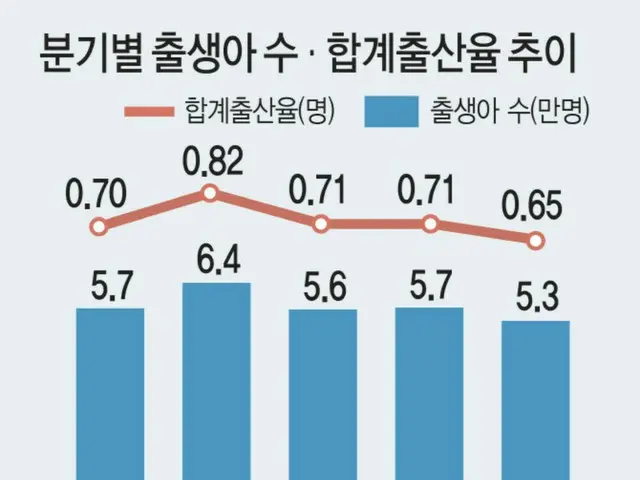The average number of children born) has not increased and is at an all-time low. The decline in birth rates was most noticeable for people in their late 20s to early 30s. From now on, the birth rate for people in their 20s and 30s will go beyond common sense in demography.
It has been pointed out that special measures are needed to raise the country's income and prevent the extinction of the nation. On the 28th, the Korea National Statistics Agency announced the 2023 Population Trends Survey Birth and Death Statistics (Provisional) and the 2023
According to the December 2023 Population Trends, South Korea's total birth rate in 2023 was 0.72. This is a decrease of 0.06 people from 2022 (0.78 people), and is a decrease of 0.06 people since 1970, when statistics began.
It was the lowest in the rain. The total birth rate has decreased for eight consecutive years since 2016 (1.17 people), hitting a record low every year. If limited to the fourth quarter of 2023, it will be 0.65 people, which is higher than all past years.
It fell below 0.7 for the first time in the quarter. Age-specific birth rates in 2023 decreased for all age groups under 45. The decline will be particularly steep among the 2030 generation, who will be subject to policies to deal with the declining birthrate.
It was. Those aged 30 to 34 (66.7 people) had the largest decrease of 6.8 people compared to the previous year, followed by those aged 25 to 29 (21.4) and 35 to 39 (43 people) with 2.6 people each.
, decreased by 1.1 people. The problem is that while marriages have increased since the height of the COVID-19 pandemic, this hasn't translated into more births. The number of marriages in 2023 is 1983 more than one year ago (
The number of cases increased by 1.0% to 193,673, and social distancing in the Tokyo metropolitan area was upgraded to the highest level, which is higher than in 2021 (192,507 cases), when the pandemic was at its most serious.
It was of a high standard. The rate of increase decreased towards the end of the year, converging to the 3% level in the fourth quarter, but in the first half alone, it trended upward enough to maintain a double-digit increase rate from January to April compared to the same month of the previous year.
The direction was clear. A Statistics Korea official said, ``Compared to the past, people are either not giving birth to children even after getting married, or they are giving birth later after marriage,'' adding, ``There is a time lag between marriage and childbirth, and we are still in the midst of the COVID-19 pandemic.
It appears that the number of births has decreased as a result of the decrease in the number of marriages." The age of childbirth is getting older. The average age at which mothers give birth to their first child has risen to 33 years old, but
In 2021, the average age for the 28 member countries of the Organization for Economic Co-operation and Development (OECD) is 29.7 years old. The proportion of elderly pregnant women aged 35 and over was 36.3%, an increase of 0.6 percentage points from the previous year. Percentage of first children (
60.1%) increased by 1.9 percentage points, exceeding the 60% level for the first time. This shows that even if they have children, they are more likely to stay with only one child.
The birth rate is also on the decline nationwide. Last year was the first time that the total birth rate for all 17 cities and prefectures fell below 1.0.
It was the first time. Until 2022, Se Jeong (1.12 people) was the only city with a population of 1, but last year it dropped to 0.97. The capital, Seoul, has the lowest birth rate in the country, dropping to 0.55.
It became a low city. South Korea's total birth rate is among the lowest in the world. As of 2021, the average birth rate of 38 OECD member countries was 1.58 children, which was higher than South Korea (0.81 children) at that time.
All other countries had at least one person. Japan, whose population is rapidly aging, also had a rate of 1.25, higher than South Korea. The number of births in 3023 will be 230,000, which is 19,200 (down 7.7%) from a year ago.
)Diminished. This means that the number of births, which reached 480,000 in 2012, has been halved in about 10 years. The ``population dead cross'' where the number of deaths (352,700 people) overtakes the number of births is 4
It's been going on for years. The Statistics Agency predicts that the declining birthrate and aging of the population will further progress, and the natural decline in the population will continue to increase. The number of children born this year is even lower than last year, and the total birth rate is 2.
The number is expected to converge to 0.68 people as predicted in the 2022-2072 Future Population Projections. Over the past 18 years, the South Korean government has spent approximately 380 trillion won (approximately 42.8 trillion yen) in response to the declining birthrate.
However, we are facing a ``population cliff'' that is unprecedented worldwide. If we don't focus on the policy of ``balancing work and family'' to increase the productive population, what remains of South Korea will disappear.
There is growing concern that there is no other way forward. Professor Choi Young of Chuo University's Department of Social Welfare said, ``The government provides various supports for raising children, such as childcare leave, childcare services, and elementary school care services.
However, the problem is that such policies do not match the labor market environment in which caregivers work.'' becomes long and ends
"Marriages are being postponed, and even if they do get married, it becomes difficult to think about having children."
2024/02/29 07:13 KST
Copyrights(C) Edaily wowkorea.jp 107

